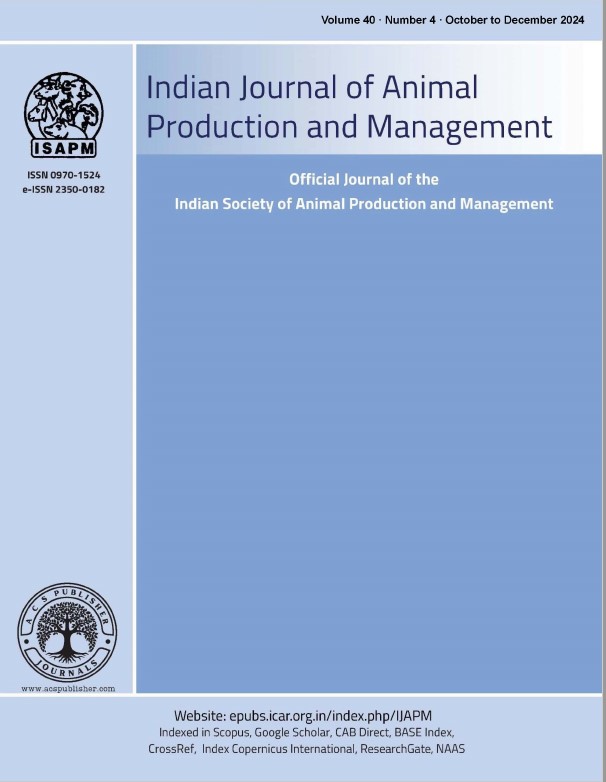Molecular Detection of Toxoplasma gondii: Accuracy, Prevalence, and Standardization of Diagnostic Protocols
DOI:
https://doi.org/10.48165/ijapm.2025.41.2.4Keywords:
Toxoplasmosis, zoonotic, infection, worldwideAbstract
Toxoplasmosis, is a common and zoonotic infection worldwide, which is a major cause of concern in the field of public health since it is caused by a protozoan parasite Toxoplasma gondii. Early and proper diagnosis is essential to the management of toxoplasmosis especially among the immunocompromised patients as well as the expectant women. Laboratory detection methods and particularly polymerase chain reaction and its variant methods have transformed the field of diagnosis due their very high sensitivity and specificity over conventional serological tests. The meta analysis is a systematic extraction and synthesis of data of recent studies of the current research evaluating the technique of molecular diagnostics of T. gondii in humans and animals. Peer-reviewed articles that were published between 2015 and 2025 in any journal have been reviewed with the purpose of evaluating molecular detection methodological differences, diagnostic accuracy, and prevalence rates. Findings have shown that multicopy nucleotide target gene amplification PCR-based assays including B1 and 18S rDNA show increased sensitivity and specificity and pooled prevalence rates distribute by host species and geographic origin. Loop mediated isothermal amplification (LAMP) and real-time PCR (qPCR) have been shown to be promising rapid and quantitative. The paper has demonstrated the strengths and weaknesses of molecular methods concluding on the importance of standardized protocols and hospitalized methods of diagnostics to get optimum results of toxoplasmosis diagnosis and control.
References
Allaith, S. A., Abdel-aziz, M. E., Thabit, Z. A., Altemimi, A. B., Abd El-Ghany, K., Giuffrè, A. M., Al-Manhel, A. J. A., Ebrahim, H. S., Mohamed, R. M., & Abedelmaksoud, T. G. (2022). Screening and molecular identification of lactic acid bacteria producing β-glucan in boza and cider. Fermentation, 8(8), 350. https://doi.org/10.3390/fermentation8080350
Almanseekanaa, L. H. (2022). Molecular study of enteropathogenic Escherichia coli isolation from clinical samples. Aca. Intl. J. Med. Sci., 1(1), 6–14. https://doi.org/10.59675/M2022-02
Almanseekanaa, L. H., Alabbas, A. K. A., Kadhim, N. J., & Ogaili, R. H. (2021). Molecular study of Pseudomonas aeruginosa isolated from different clinical cases. Biochemical and Cellular Archives, 21(2), 3079–3082. https://www.scopus.com/inward/record.uri?eid=2-s2.0-85144244268&partnerID=40&md5=35c7c6c9bbc9e6136914c6dad1e3ce76
Almanseekanaa, L. H., & Ogaili, R. H. (2023). Comparison between serological and molecular identification of Vibrio cholerae. Aca. Intl. J. P. Sci., 1(2), 41–56. https://doi.org/10.59675/P125
Alsafar, S. H. H., Abd, A. R., & Mahdi, I. G. (2023). Isolation and identification of Campylobacter coli and Campylobacter lari from humans, local milk, and milk products using classical and molecular techniques in Karbala province. Aca. Intl. J. V. Med., 1(1), 35–51. https://doi.org/10.59675/V117
Al-Shuhaib, M. B. S., Hashim, H. O., & Al-Shuhaib, J. M. B. (2025). D-Glucosamine is a potential urease inhibitor from Middle Eastern medicinal plants for combatting Helicobacter pylori infections; a molecular docking and simulation approach. Biochem Genet, 63, 239–260. https://doi.org/10.1007/s10528-024-10709-5
Burg, J. L., Grover, C. M., Pouletty, P., & Boothroyd, J. C. (1989). Direct and sensitive detection of a pathogenic protozoan, Toxoplasma gondii, by polymerase chain reaction. Journal of Clinical Microbiology, 27(8), 1787–1792.
Cenci-Goga, B. T., et al. (2011). Detection of Toxoplasma gondii in meat samples by PCR. Foodborne Pathogens and Disease, 8(6), 715–719.
Dubey, J. P. (2016). Toxoplasmosis of Animals and Humans (2nd ed.). CRC Press.
Edo, G. I., Mafe, A. N., Ali, A., Akpoghelie, P. O., Yousif, E., Isoje, E. F., Igbuku, U. A., Zainulabdeen, K., Owheruo, J. O., Essaghah, A. E., & Umar, H. (2025). Evaluation of different antimicrobial polymeric coatings for food contact surfaces. Discover Food, 5(1), 1–48.
Homan, W. L., Vercammen, M., De Braekeleer, J., & Verschueren, H. (2000). Identification of a 200- to 300-fold repetitive 529 bp DNA fragment in Toxoplasma gondii, and its use for diagnostic and quantitative PCR. International Journal for Parasitology, 30(1), 69–75.
Kadhim, N. J., Al-Karawi, N. J., Almanseekanaa, L. H., & Ogaili, R. H. (2021). Molecular characterization and antibiotic pattern ofthe Klebsiella pneumoniae. Veterinary Practitioner, 22(2), 1–6. https://www.scopus.com/inward/record.uri?eid=2-s2.0-85127004096&partnerID=40&md5=09cfa9aef8e27fd1a4d329aa3992fa08
Kim, K., et al. (2023). Molecular detection of Toxoplasma gondii in blood samples of domestic ruminants. Pathogens, 12(2), 174.
Lkanaa, L. H., Jasim, A. M., & Mohammed, R. H. (2018). Causal association of Toxoplasma gondii seropositivity with adverse pregnancy outcome(s) in Iraqi women, a cat-based dilemma. J. Entomol. Zool. Stud., 6(2), 1812–1815.
Montoya, J. G., & Liesenfeld, O. (2004). Toxoplasmosis. The Lancet, 363(9425), 1965–1976.
Muhammed, H. A. (2024a). Evaluate the concordance between two diagnostic methods, RT-PCR and ELISA techniques for the detection of CCHFV in Karbala City. Aca. Intl. J. V. Med., 2(1), 48–58. https://doi.org/10.59675/V217U
Zulkifli, S. A. (2022). The rules of molecular technique in diseases identification. Acad Int J Med Sci., 1(1), 23–27. https://doi.org/10.59675/M2022-04
Pomares, C., & Montoya, J. G. (2016). Laboratory diagnosis of toxoplasmosis and interpretation of results. The Clinical Microbiology Newsletter, 38(12), 99–104.
Puspitasari, H., et al. (2024). Molecular detection of toxoplasmosis in wild rats using loop-mediated isothermal amplification assay. Veterinary World, 17(7), 1575–1580.
Reischl, U., Bretagne, S., Krüger, D., Ernault, P., & Costa, J. M. (2003). Comparison of two DNA targets for the diagnosis of toxoplasmosis by real-time PCR using fluorescence resonance energy transfer hybridization probes. BMC Infectious Diseases, 3, 7.
Robert-Gangneux, F., & Dardé, M. L. (2012). Epidemiology of and diagnostic strategies for toxoplasmosis. Clinical Microbiology Reviews, 25(2), 264–296.
Srinivasan, K., Altemimi, A. B., Narayanaswamy, R., Vasantha Srinivasan, P., Najm, M. A., & Mahna, N. (2023). GC‐MS, alpha‐amylase, and alpha‐glucosidase inhibition and molecular docking analysis of selected phytoconstituents of small wild date palm fruit (Phoenix pusilla). Food Science & Nutrition, 11(9), 5304–5317.
Whiting, P. F., et al. (2011). QUADAS-2: A revised tool for the quality assessment of diagnostic accuracy studies. Annals of Internal Medicine, 155(8), 529–536.

